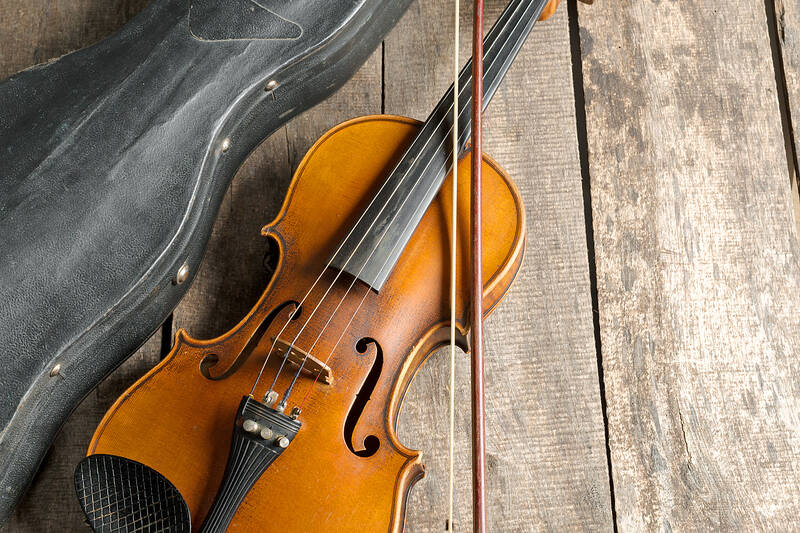Amid the audience’s hushed whispers of eager anticipation, the first notes of the violin flow out across the concert hall, elegantly marking the beginning of a splendid music concert. As the violin strings vibrate under the bow, let us contemplate their journey to become what they are today.
Surprisingly, traditional violin strings are crafted mainly from sheep intestines. These gut strings undergo a rigorous process to ensure the complete removal of impurities. Following the sheep’s slaughter, the intestines have to be promptly harvested and thoroughly cleaned. The guts are then twisted into strings, dried and polished before being ready for their time on the violin.
Pure gut strings are unique in their warm, smooth and expressive tone. However, they have their shortcomings. They are prone to producing a lower volume, vulnerable to changes in conditions such as humidity, and lacking in durability. To overcome these challenges, string makers began winding metal wire around gut strings around 1660, especially around the G string. This string, being the lowest-pitched and thickest among the violin’s four strings of G, D, A and E, benefited significantly from better durability and sound clarity.

Photo: Freepik / 照片:Freepik提供
The necessity for alternative string materials became more pressing during World War II because of a shortage of animal guts. Consequently, metal, especially steel, became the norm. Synthetics, offering a mix of the warm tone of gut and stability of steel, gained popularity later in the century, with the Dominant series being a notable example. This string brand was launched by Austrian company Thomastik-Infeld in 1970.
That being said, both pure and wound gut strings continue to be used, providing violinists with a spectrum of options depending on different playing styles and requirements. Next time you hear the sweet strains of a violin, remember that behind every note lies a pursuit of excellence in both instrument production and artistic effects.
在觀眾熱切期待的低聲私語中,小提琴的第一個音符流淌於整間音樂廳,優雅地為一場精彩的音樂會揭開序幕。在小提琴弦振動於琴弓之下的同時,讓我們思考小提琴弦是如何一路發展變成今日的模樣。
令人驚訝的是,傳統的小提琴弦主要是由羊腸製成的。這些羊腸弦會經過嚴謹的處理過程,以確保完全去除雜質。在羊隻被宰殺後,就必須迅速收割羊腸並徹底清潔。然後再將羊腸扭成弦、風乾和打磨,才能準備好應用在小提琴上。
純的羊腸弦在音色方面溫暖、圓滑和富有表現力而獨一無二。然而,它們也有缺點。純的羊腸弦產生的音量往往較低,容易受濕度等條件變化的影響,且缺乏耐久性。為了克服這些挑戰,製作琴弦的人於西元1660年左右便開始在羊腸弦周圍包纏金屬絲,特別是在G弦上。由於這根弦在小提琴四根弦(G、D、A 和E)中是音調最低且口徑最粗的一根,因而從更好的耐久性和音質清晰度當中大大地受惠。
在二戰期間,由於動物腸的短缺,對琴弦替代材料的需求變得更加迫切。因此,金屬便成為琴弦材料的常態,尤其是鋼。之後合成材料在這個世紀後期變得流行,合成材料提供了融合羊腸弦的溫暖音色和鋼材的穩定性的選擇,Dominant系列就是一個顯例。這個琴弦品牌是由奧地利公司托馬斯提克-因費爾德於西元1970年推出的。
話雖如此,純的羊腸弦和金屬包纏的羊腸弦仍繼續受到使用,為小提琴家提供了一系列選擇,取決於不同的演奏風格和要求。下次當你聽到小提琴的甜美樂音時,請記住,每個音符背後都蘊藏著一種對樂器製作上和藝術效果上的卓越的追求。
MORE INFORMATION
intestine n. 腸
rigorous adj. 嚴謹的;嚴格的
impurity n. 雜質
durability n. 耐用性
pressing adj. 緊迫的;迫切的
strains n. 樂音
KEY VOCABULARY
1. vibrate v. (使)振動;(使)震動;(使)顫動
If you don’t want your smartphone to vibrate when there is an incoming call, change the setting.
如果您不希望智慧型手機在有來電時振動,請更改設定。
2. removal n. 移除;去除
A professional cleaning service can handle the removal of dust from every surface in your home.
專業的清潔服務可以去除家中每個表面的灰塵。
3. slaughter n. 屠宰;殺戮
Pigs on this farm are raised for slaughter to meet market demand for pork products.
這座農場所飼養的豬隻是用於屠宰的,以滿足市場對豬肉產品的需求。
4. gut n. 羊腸線
For today’s performance, Tommy chose gut strings for his violin to achieve a warmer sound.
針對今日的演奏,湯米為他的小提琴選擇了羊腸弦,以獲得更溫暖的聲音。
5. shortcoming n. 缺點;短處
Providing extra support helps students make up for shortcomings in specific subjects.
提供額外支援可以幫助學生彌補特定學科的短處。
6. norm n. 常態;規範;標準
Offering a handshake as a greeting is a norm in many business and social situations.
在許多商務和社交情境中,握手作為問候是一種常態。
7. synthetic n. 合成物;合成材料
Sportswear for athletes is often made of synthetics for better comfort and performance.
運動員的運動服通常由合成材料製成,以提高舒適度和性能。
8. violinist n. 小提琴家
The orchestra invited a talented violinist to perform a beautiful solo at the concert.
管弦樂團邀請了一位才華橫溢的小提琴家在音樂會上演奏了一段優美的獨奏。
9. spectrum n. 範圍;幅度;光譜
The workshop covered a broad spectrum of topics related to professional development. 這場工作坊涵蓋了與專業發展相關、範圍很廣的主題。
學習音檔: https://magazine.english4u.net/Magdata/menu/5o4pk
《空中美語》雜誌APP免費下載: https://www.english4u.net/apps/index.aspx
免費收聽當月《空中美語》雜誌課文朗讀及解析 !
文章由AMC空中美語授權使用: https://www.english4u.net

In an effort to fight phone scams, British mobile phone company O2 has introduced Daisy, an AI designed to engage phone con artists in time-wasting conversations. Daisy is portrayed as a kindly British granny, exploiting scammers’ tendency to target the elderly. Her voice, based on a real grandmother’s for authenticity, adds to her credibility in the role. “O2” has distributed several dedicated phone numbers online to direct scammers to Daisy instead of actual customers. When Daisy receives a call, she translates the scammers’ spoken words into text and then responds to them accordingly through a text-to-speech system. Remarkably, Daisy

Bilingual Story is a fictionalized account. 雙語故事部分內容純屬虛構。 Emma had reviewed 41 resumes that morning. While the ATS screened out 288 unqualified, she screened for AI slop. She could spot it a mile away. She muttered AI buzzwords like curses under her breath. “Team player.” “Results-driven.” “Stakeholder alignment.” “Leveraging core competencies.” Each resume reeked of AI modeling: a cemetery of cliches, tombstones of personality. AI wasn’t just changing hiring. It was draining the humanity from it. Then she found it: a plain PDF cover letter. No template. No design flourishes. The first line read: “I once tried to automate my

Every May 1, Hawaii comes alive with Lei Day, a festival celebrating the rich culture and spirit of the islands. Initiated in 1927 by the poet Don Blanding, Lei Day began as a tribute to the Hawaiian custom of making and wearing leis. The idea was quickly adopted and officially recognized as a holiday in 1929, and leis have since become a symbol of local pride and cultural preservation. In Hawaiian culture, leis are more than decorative garlands made from flowers, shells or feathers. For Hawaiians, giving a lei is as natural as saying “aloha.” It shows love and

1. 他走出門,左右看一下,就過了馬路。 ˇ He walked outside, looked left and right, and crossed the road. χ He walked outside and looked left and right, crossed the road. 註︰並列連接詞 and 在這句中連接三個述語。一般的結構是 x, y, and z。x and y and z 是加強語氣的結構,x and y, z 則不可以。 2. 他們知道自己的弱點以及如何趕上其他競爭者。 ˇ They saw where their weak points lay and how they could catch up with the other competitors. χ They saw where their weak points lay and how to catch up with the other competitors. 註:and 一般連接同等成分,結構相等的單詞、片語或子句。誤句中 and 的前面是子句,後面是不定詞片語,不能用 and 連接,必須把不定詞片語改為子句,and 前後的結構才相等。 3. 她坐上計程車,直接到機場。 ˇ She took a cab, which took her straight to the airport. ˇ She took a cab and it took her straight